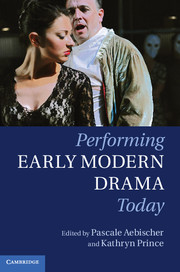
November 27, 2012, by Peter Kirwan
Performing Early Modern Drama Today (Pascale Aebischer and Kathryn Prince)
This post is a prelude to a full review of Pascale Aebischer and Kathryn Prince’s new edited collection, Performing Early Modern Drama Today (Cambridge, 2012), which is forthcoming in a future issue of Cahiers Elisabethains. I trump the book on this blog because it is, I will be arguing, one of the most important collections for the consideration of modern performance of Shakespeare’s contemporaries to be published in many years, as well as being a fine model for the kinds of scholarly collaboration we should be pursuing.
The book’s raison d’etre is to establish new critical frameworks for considering Shakespeare’s contemporaries on the modern stage. As is established early on, and proven in the extensive appendices, the performance of non-Shakespearean early modern drama is in the main restricted to a core canon of plays that recur on syllabi and need to be continually rediscovered, lacking the institutional structures for reviewing and archiving that serve Shakespeare so well in creating a continuous narrative of development in performance. Further, this group of dramas is often used (deliberately or by default) to reinforce the centrality of Shakespeare to theatrical and educational institutions, often characterised using broad terms such as “the Jacobean” (read: sex and violence).
Yet as this collection demonstrates, the relative unfamiliarity of Shakespeare’s contemporaries also allows them to stand at the vanguard of experimentation and innovation in practice and research terms. Whether in the use of the plays for thorough engagements with original practices at the Blackfriars in Staunton, Virginia, with actors genuinely unencumbered by prior expectations; in the higher education classroom where students’ minds can focus on the performative and spatial work offered by The Changeling; or in the embodied discoveries of site-specific theatre such as that utilised by angels in the architecture for its production of Dido, Queen of Carthage, the plays create a space for play and inversion that moves far beyond the glossing of Shakespeare.
I will return to the book in full in my print review, but the collaborators here need to be commended for reopening a too-often-ignored area of performance criticism. Selfishly, it is also an area which is importantly served by blogs such as this, that attempt to assert the importance of the wider Elizabethan/Jacobean/Caroline repertoire on the modern stage and establish a history of performance for these plays. If nothing else, Aebischer and Prince’s volume reminds me of the extent to which sites such as this are needed if Shakespeare’s contemporaries are to be elevated from their “You may also be interested in…” status to the living, breathing theatrical masterpieces that so many of them are.

I wasn’t aware of the Angels in Architecture’s production til now! I wish I had been able to see & hear it. Do you think there’s something about Marlowe plays that lend themselves to site-specific performances? I’m going to see a Doctor Faustus production in Boston, Massachusetts that’s set in a church, in February, and there was another like that in another city in the U.S. recently.
Hi Patrick – I’m so glad the chapter brought your attention to it! Thats an interesting question – I certainly think religious spaces allow Marlowe’s devilish sense of transgression to flourish in a very literal, embodied way, which was something we found in the church of St Barnabas at Soho. There’s also I think a broader sense in which site specific practices support and enrich textual engagement which perhaps has more to offer somewhat marginalised texts than orthodox stagings, though I wouldn’t regard Dr Faustus as belonging to that category.